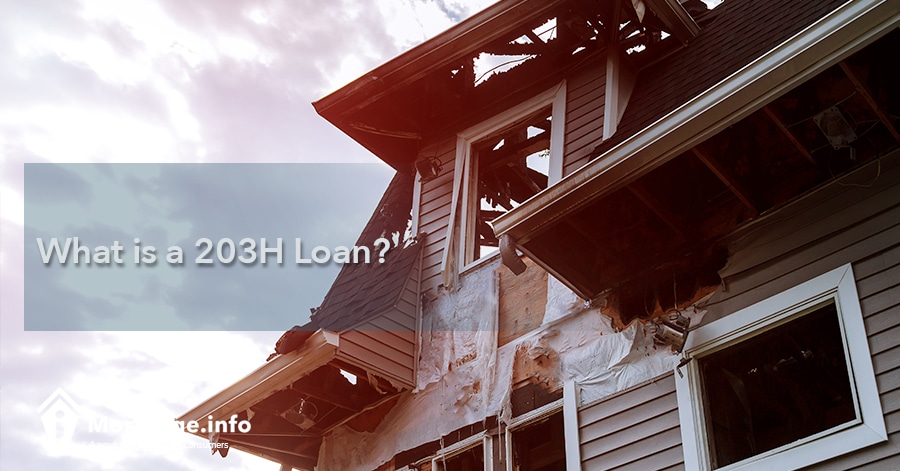Victims of a natural disaster often lose everything, including their home. The FHA 203H loan helps these victims become homeowners again. The 203H loan has unique qualifying requirements and stipulations. Keep reading to learn more about it.
Get Matched with a Lender, Click Here.
Understanding the 203H Loan
The government helps borrowers in Presidentially declared disaster areas with the 203H loan. The program makes it easier to obtain a mortgage and become a homeowner without the typical requirements that disaster victims may not have.
The 203H program protects lenders with mortgage insurance. The mortgage insurance, like any other insurance, protects the lenders against defaulted loans. You are eligible for the program if:
- They owned a home located in a Presidentially declared disaster area
- They lost their home completely due to the disaster
- The home needs complete reconstruction or replacement
- You must reconstruct or purchase a home as your primary residence
What’s Required?
The FHA requires the following:
- You don’t need a down payment. You can get 100% financing. The only expense you are responsible for is the closing costs or prepaid interest, taxes, or insurance. If you can’t pay the prepaid expenses, the seller or lender can assist with the expense.
- You will need to pay upfront mortgage insurance, just as is the case on a standard FHA loan. The upfront mortgage insurance helps fund the FHA’s reserves, which allows them to write loans such as these.
- You will be required to pay annual mortgage insurance premiums. You pay this amount monthly in addition to your mortgage payment.
- You must abide by the FHA loan limits for the area. The program is for low and moderate-income families that can’t afford to rebuild or buy a home.
- You need at least a 500 credit score, which is lower than a typical FHA loan that requires a 580 credit score.
- You can have derogatory credit as long as it pertains to the natural disaster. If you were already late on your mortgage, you cannot have been more than three months late at the time of the disaster.
- Your debt-to-income ratio shouldn’t exceed 43%, however, some lenders do allow debt ratios up to 50% for disaster victims. You should have a great credit score, stable income, or other compensating factors to get the 50% debt ratio approval.
- There are no borrower income limits. You can make as much as you want and still qualify for the program.
- Ideally, you should have a 2-year employment history at the same job. If you lost your job due to the disaster, lenders are often able to grant exceptions. If you can’t prove your employment because of the natural disaster, you may be able to get by with a verbal verification of employment rather than paperwork.
Click to See the Latest Mortgage Rates.
Interest Rates and Closing Costs
FHA 203H loans typically have lower interest rates than conventional loans, which are along the lines of standard FHA loans. The loan program is meant to help those that lost everything. The interest rates charged are lower to help make that happen. Because borrowers also pay mortgage insurance, FHA interest rates tend to be lower to keep the mortgages affordable.
You can expect the typical closing fees on the FHA 203H loan. You’ll pay the upfront mortgage insurance plus all lender fees and third party fees. Just like is the case with the standard FHA loan, though, you can get help:
- You can pay the fees in cash if you have the funds
- You can ask the seller to assist you with up to 6% of the loan amount to cover the closing costs
- You can ask the lender for a no closing cost loan, which may have a higher interest rate, but means you don’t need to bring cash to the closing
Keep in mind that you’ll also need to set up an escrow account. This helps cover the cost of your taxes and insurance. The escrow account isn’t a part of the closing fees, but it does increase the amount of cash you’ll need at the closing. Typically, you need at least a 2-month cushion to cover the taxes and insurance payments.
The Mortgage Terms
The FHA 203H loan is available in either a 15 or 30-year term. You can choose from a fixed rate or an ARM. If you choose the adjustable rate mortgage, you can choose from a 3-year, 5-year, 7-year, or 10-year adjustable rate loan that adjusts once per year.
You should also know that there are loan limits as to how much you can borrow. This is the same as it is for standard FHA loans. The loan limit depends on the area that you live and the cost of living there. Your lender can tell you the loan limit for your area.
The FHA 203H loan is a great program to help those that suffered the loss of their home due to a natural disaster. If you live in a Presidentially declared disaster area, look into your options for this loan. You can shop around with any FHA lender, like any other loan, ensuring that you get the best deal.

